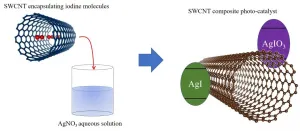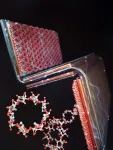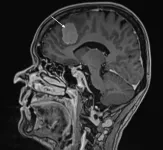A bright future: Using visible light to decompose CO2 with high efficiency
Scientists find a way to efficiently use visible light from the sun to break down CO2, open doors to novel means of alleviating global warming
2021-06-21
(Press-News.org) Carbon dioxide (CO2) emissions from human activities have risen drastically over the last century and a half and are seen as the primary cause of global warming and abnormal weather patterns. So, there has been considerable research focus, in a number of fields, on lowering our CO2 emissions and its atmospheric levels. One promising strategy is to chemically break down, or 'reduce,' CO2 using photocatalysts--compounds that absorb light energy and provide it to reactions, speeding them up. With this strategy, the solar powered reduction of CO2, where no other artificial source of energy is used, becomes possible, opening doors to a sustainable path to a sustainable future.
A team of scientists led by Drs. Shinji Kawasaki and Yosuke Ishii from Nagoya Institute of Technology, Japan, has been at the forefront of efforts to achieve efficient solar-energy-assisted CO2 reduction. Their recent breakthrough is published in Nature's Scientific Reports.
Their research began with the need to solve the limited applicability problem of silver iodate (AgIO3), a photocatalyst that has attracted considerable attention for being useful for the CO2 reduction reaction. The problem is that AgIO3 needs much higher energy than that which visible light can provide to function as an efficient photocatalyst; and visible light is the majority of solar radiation.
Scientists have attempted to work around this efficiency problem by combining AgIO3 with silver iodide (AgI), which can efficiently absorb and utilize visible light. However, AgIO3-AgI composites have complicated synthesis processes, making their large-scale manufacturing impractical. Further, they don't have structures that offer efficient pathways for the transfer of photoexcited electrons (electrons energized by light absorption) from AgI to AgIO3, which is key to the composite's catalytic activity.
"We have now developed a new photocatalyst that incorporates single-walled carbon nanotubes (SWCNTs) with AgIO3 and AgI to form a three-component composite catalyst," says Dr. Kawasaki, "The role of the SWCNTs is multimodal. It solves both the synthesis and the electron transfer pathway problems."
The three-component composite's synthesis process is simple and involves just two steps: 1. Encapsulating iodine molecules within the SWCNT using an electrochemical oxidation method; and 2. Preparing the composite by immersing the resultant of the previous step in an aqueous solution of silver nitrate (AgNO3).
Spectroscopic observations using the composite showed that during the synthesis process, the encapsulated iodine molecules received charge from the SWCNT and converted into specific ions. These then reacted with AgNO3 to form AgI and AgIO3 microcrystals, which, due to the initial positions of the encapsulated iodine molecules, were deposited on all the SWCNTs uniformly. Experimental analysis with simulated solar light revealed that the SWCNTs also acted as the conductive pathway through which photoexcited electrons moved from AgI to AgIO3, enabling the efficient reduction of CO2 to carbon monoxide (CO).
The incorporation of SWCNTs also allowed for the composite dispersion to be easily spray-coated on a thin film polymer to yield flexible photocatalytic electrodes that are versatile and can be used in various applications.
Dr. Ishii is hopeful about their photocatalyst's potential. "It can make the solar reduction of industrial CO2 emissions and atmospheric CO2 an easy-to-scale and sustainable renewable energy-based solution tackling global warming and climate change, making people's lives safer and healthier," he says.
The next step, the team says, is to explore the possibility of using their photocatalyst for solar hydrogen generation. Perhaps, humanity's future is bright after all!
INFORMATION:
About Nagoya Institute of Technology, Japan
Nagoya Institute of Technology (NITech) is a respected engineering institute located in Nagoya, Japan. Established in 1949, the university aims to create a better society by providing global education and conducting cutting-edge research in various fields of science and technology. To this end, NITech provides a nurturing environment for students, teachers, and academicians to help them convert scientific skills into practical applications. Having recently established new departments and the "Creative Engineering Program," a 6-year integrated undergraduate and graduate course, NITech strives to continually grow as a university. With a mission to "conduct education and research with pride and sincerity, in order to contribute to society," NITech actively undertakes a wide range of research from basic to applied science.
Website: https://www.nitech.ac.jp/eng/index.html
About Professor Shinji Kawasaki and Associate Professor Yosuke Ishii from Nagoya Institute of Technology, Japan
Dr. Shinji Kawasaki is a Professor of the Department of Life Science and Applied Chemistry at Nagoya Institute of Technology, Japan. His research interests include the use of nanocarbon and nanocarbon composites for various applications, such as energy storage, hydrogen generation, chemical modification, carbon nanotube synthesis, lighting devices, and graphene synthesis. To date, he has 107 publications to his name.
Dr. Yosuke Ishii is an Assistant Professor at the Department of Life Science and Applied Chemistry at Nagoya Institute of Technology, Japan. He obtained his Ph.D. from Nagoya Institute of Technology in 2014. To date, he has 43 publications to his name.
[Attachments] See images for this press release:

ELSE PRESS RELEASES FROM THIS DATE:
2021-06-21
Scientists have used a compound made from a starch derivative and baking soda to help convert mechanical to electrical energy. The approach, developed by scientists at Daegu Gyeongbuk Institute of Technology (DGIST), with colleagues in Korea and India, is cost-effective and biocompatible, and can help charge low-energy electronics like calculators and watches. The details were published in the journal Advanced Functional Materials.
"Triboelectric nanogenerators harvest mechanical energy and convert it into an electric current," explains DGIST robotics engineer Hoe Joon Kim. "But many of the materials used in these devices are considered a biohazard and are not suitable for wearable ...
2021-06-21
Meningiomas, which originate in the meninges surrounding the brain, are the most common type of benign brain tumours. The primary treatment for meningiomas is neurosurgery. Since the risks associated with surgical treatment increase as people get older and develop other diseases, over 80-year-old patients with brain tumours are not operated on almost anywhere in the world.
In Finland, the life expectancy and functional capacity of the elderly population have improved in recent decades, while the number of elderly brain tumour patients who are in good condition is continuously growing. This is why surgeries have increased in prevalence at the Neurosurgery Clinic of the Helsinki University Hospital in the treatment of elderly patients who have lost their ...
2021-06-21
Tropical cyclones (TCs) can bring strong wind, heavy rain, and storm surge. Meteorologists are concerned that the effects of global warming may change how these storms impact humans.
Scientists use global climate models (GCMs) in climate change studies to simulate future changes in temperature, precipitation, etc. However, due to their coarse resolutions, many models cannot properly simulate small-scale weather and climate systems like TCs, which means that they cannot capture all the dynamic processes within a TC.
A study led by Prof. Gao Xuejie from the Institute ...
2021-06-21
Dissatisfaction with married life raises the risk of dying from a cerebrovascular accident: A new Tel Aviv University study reveals that perceiving marriage as unsuccessful is a significant predictor of death from a CVA and premature death among men, no less that well-known risk factors such as smoking and lack of physical activity. The study was based on extensive health data from more than 30 years of research that tracked the deaths of 10,000 Israeli men.
The study was led by researchers from the School of Public Health at the Sackler Faculty of Medicine, Tel Aviv University: Prof. Uri Goldbort from the Department of Epidemiology and Preventive Medicine, who initiated and managed the long-term study; Dr. Shahar Lev-Ari, the head ...
2021-06-21
Research has found that training stroke survivors to walk at a faster speed during recovery can help improve the brain function that enables people to walk and perform another task simultaneously, known as dual-task walking. The research, led by academics at Oxford Brookes University, was funded by the Stroke Association.
People who've had a stroke often struggle to walk and do tasks that involve thinking at the same time, for example, activities such as walking and holding a conversation, or planning what to do next. To effectively walk in the community, cognitive effort is needed to navigate safely and deal with distractions. Many people fail to regain this ability after a stroke.
Dual-task ...
2021-06-21
Vitamin B12 is essential for proper functioning of the nervous system and blood cells and also plays an important role in DNA synthesis in all our cells. Vitamin B12 deficiency causes fatigue, muscle weakness, headaches, and sometimes even serious neurological symptoms. Usually, the necessary amounts of B12 are absorbed from food in our digestive tract; however, in 0.1-2% of individuals, the epithelial lining of the stomach fails to produce a glycoprotein intrinsic factor that is needed for proper absorption of B12. This leads to vitamin B12 deficiency and a certain type of anemia called pernicious anemia. Pernicious ...
2021-06-21
The research team used data from world renowned health study Children of the 90s, to answer three research questions:
Is school enjoyment patterned by biological sex at birth, socioeconomic background of cognition?
How does school enjoyment relate to GCSE achievement?
Does school enjoyment relate to social or sex differences in GCSE achievement?
The team found that pupil's school enjoyment measured at six years old is patterned by their sex and cognitive ability but not their family's socioeconomic background. For example, girls were twice as likely to report enjoying school than boys. School enjoyment strongly related to GCSE achievement at age 16 even after consideration of their socioeconomic background ...
2021-06-21
UNIVERSITY PARK, Pa. -- Workers in the service industry are often pressured by their employers to give friendly "service with a smile." New research suggests that when those employees also rely on tips to earn a living, it creates a power dynamic between the employee and customer that may increase the likelihood of sexual harassment on the job.
Alicia Grandey, liberal arts professor of psychology at Penn State, said the findings could give insight into how companies can help reduce sexual harassment from customers, including raising employees' hourly wages.
"It may not be necessary to completely eliminate customer tips, but rather reduce the dependence on tips by offering a livable wage," Grandey said. "Based on our results, if employees were ...
2021-06-21
WASHINGTON (June 21, 2021)--Previous research has suggested that the stress of discrimination may play a role in the development of health problems that disproportionately affect lesbian, gay and bisexual individuals. A study published today finds that when lesbian, gay and bisexual adults are exposed to even mild anti-gay prejudice, it triggers bodily changes such as increases in blood pressure that can contribute to heart disease.
"This study provides strong evidence that when LGB people experience anti-gay prejudice, their bodies respond with increases in heart rate and blood pressure, and in the stress hormone cortisol," David M. Huebner, a professor of prevention and community health at the George Washington University and lead author of the study, said. "When the body responds ...
2021-06-21
Lesbian, gay and bisexual people who encounter homophobic attitudes experience increases in heart rate, blood pressure and stress hormones, potentially putting them at risk for multiple health problems, according to research published by the American Psychological Association.
"This study shows the potentially toxic impact discriminatory attitudes can have on lesbian, gay and bisexual people's health," said lead author David M. Huebner, PhD, associate professor of prevention and community health at The George Washington University. "This is just one more, among many, corrosive effects of homophobia."
In the study, published in the journal Health Psychology, researchers looked at 134 lesbian, gay and bisexual ...
LAST 30 PRESS RELEASES:
[Press-News.org] A bright future: Using visible light to decompose CO2 with high efficiency
Scientists find a way to efficiently use visible light from the sun to break down CO2, open doors to novel means of alleviating global warming





